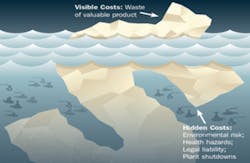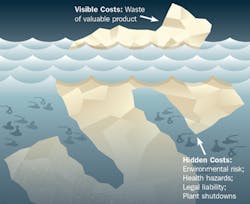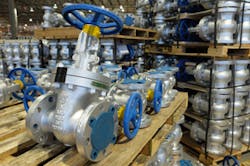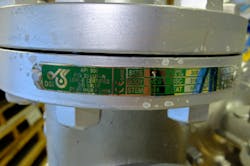Fugitive emissions are any chemical in physical form that can leak unanticipated within an installation. Valves account for more than 51 percent of fugitive emissions, and greenhouse gases (GHGs) are part of this. Leak screening should be completed on accessible components using a portable organic vapor analyzer in accordance with U.S. EPA Method 21 or using alternate methods that provide an equivalent result.
Operators in refineries or chemical/petrochemical plants must keep greenhouse gas (GHG) and environmental regulations for fugitive emissions in mind. One area in which this is extremely important is in the processing of oil and gas.
Knowing how to select valves that will meet or exceed volatile organic compound fugitive emission limits is critical, as the costs are exorbitantly high if an operator fails to meet the requirements.
End users should obtain test data that will allow for direct comparisons between valve packing, gaskets, and other sealing components. Without data, end-users are guessing which options are best for their applications. Operations/field data based on past experience helps analyze the valve and packing options.
Most companies require real-time testing, which will provide comparable fugitive emissions in parts per million (PPM) of hydrocarbons and chemicals. These tests include multiple test cycles that represent the plant conditions within a laboratory. These tests can be conducted at reasonable costs and within a reasonable timeframe.
A few laboratories in North America are qualified and have developed a simple test procedure that can be adjusted to accommodate any off-the-shelf valve and provide the fugitive emissions in PPM, which is needed to understand how a valve will perform once it is in service.
READ ALSO: Addressing the Big Bang—Prevention strategies for water hammer in SAGD process pipelines
Why fugitive emissions of valves?
Valves account for more than 51 percent of fugitive emissions, and GHGs are part of this (Figure 2).
Compliance standards should be created by valve manufacturers that minimally include the following:
- Design of sealing components
- Selection of materials
- Prototype qualification of valves
- Production test of valves
- Fugitive emission compliance on-site
To maintain consistency, each standard should be quality checked. If any anomalies occur, the whole test cycle must be repeated. The steps to eliminate or limit valve fugitive emissions that can lead to global warming include leak detection and repair and basic control and monitoring strategies.
Leak detection and repair (LDAR)
The U.S. Environmental Protection Agency (EPA) aggressively pursues fugitive emission violations. The agency requires Method 21 Department of Energy (DOE) monitoring of valves, and it mandates the repair of leaks. To minimize hazardous or toxic air pollutant emissions, the EPA also mandates the use of low-emission (Low-E) valves or Low-E packing.
Valves and packing are considered Low-E if they have the following characteristics:
- They are type tested (by the valve/packing manufacturer) and have a written warranty not to leak above 100 PPM. The manufacturer will replace the valve if it emits above this limit at any time during the first five years.
- They are type tested and did not leak more than 500 PPM and, on average, leaked less than 100 PPM.
- Valves that are extensions of the qualified types above — provided temperature, pressure and all major characteristics affecting the valve sealing performance are the same — are also considered Low-E.
Control strategies
The key elements for effective, long-term control of fugitive emissions are:
- The application of the best available technology and standards, including the development of monitoring programs, operating procedures, and performance objectives for controlling fugitive emissions;
- Implementation of management systems; and
- Corporate commitment to the implementation and maintenance of a directed inspection & maintenance (DI&M) program to detect and prevent leaks.
The first step in controlling fugitive equipment leaks should always be to minimize the potential for leaks by applying proper design and material-selection standards, following the manufacturer’s specifications for the installation, using and maintaining the components, and implementing practical control technologies (such as reduction, recovery and treatment systems).
A management system is needed to establish objective performance targets and to implement ongoing monitoring and predictive maintenance programs to ensure that leaks are detected and remain well controlled.
DI&M program
The first step is to determine which types of components will be targeted for regular leak screening. The objective is to minimize the potential for leaks in the most practicable way possible. This is accomplished by focusing the efforts on the types of components and service applications most likely to offer significant cost-effective control opportunities. Non-target components are subjected to coarse or less frequent screening.
Typically, a facility will phase in the DI&M program across a certain number of years by progressively adding to the list of targeted components until all key components are targeted. Once a leak is detected, regardless of whether it is a target or non-target component, the decision must be made whether to repair the leak. Once the maintenance professionals or operators have decided to repair a leak, the repair should be completed within a reasonable period of time or at the next facility turnaround if a major shutdown is required.
A facility may simply choose to repair or fix the leak. If it is not a simple repair, an operator may choose to schedule the repair during the next shut down without quantification, or alternatively, the leak should be measured or estimated to determine if it is economical to repair or too dangerous to wait for repair.
If an operator determines that repairing the leak is not economical, this should be documented based on reliable quantification of the amount of leakage and the repair costs. If a leak poses a health, safety or environmental concern, then it must be repaired regardless of economics.
Editor’s note: Following the initial publication of this article in the May 2014 issue of Flow Control magazine (pages 16-19), new information has become available:
- The U.S. EPA has acknowledged and adopted API624, which was officially issued in Feb. 2014.
- Labs in the U.S. are busy testing valves for a dozen valve manufacturers.
- The first few manufacturers have started stocking/marketing valves compliant to API624 (see photos below)
- End-users are insisting on improved product quality and low emissions requirements.
Fugitive emission control is becoming more common as a condition of a facility’s operating approval. Accordingly, it is useful to consider a definition that corresponds to those typically applied in other industries. A leak may be defined as a screening concentration of 10,000 PPM or more for the purposes of deciding whether to measure the emission rate and evaluate the practicality of making repairs. Below this threshold, the emissions generally become too small to quantify. Moreover, only the top 5 percent to 10 percent of leaking components usually account for 80 percent to 90 percent of the emissions at a facility. As a result, limited value is achieved in dedicating resources to measure or estimate emissions from components that do not meet the screening value identified. However, facilities may still choose to repair leaks that are below 10,000 PPM.
Several emerging technologies have the potential to improve the efficiency and effectiveness of leak detection programs and replace U.S. EPA Method 21. These technologies include:
- Differential lasers to measure atmospheric concentrations of component gases
- Computer analysis of ambient air sample trends to estimate leak source location and volumes
- Infrared optical technology to visually inspect the components
Leak testing requirements
Leak screening should be completed on accessible components using a portable organic vapor analyzer in accordance with U.S. EPA Method 21, or by using alternate methods that provide an equivalent result. In some cases, Method 21 has been considered too slow and labor intensive and better suited for large facilities. For these reasons, other methods may be used.
These other methods may also allow operators to evaluate components that may not have otherwise been accessible. Further details regarding some new codes since ISO and API are currently updating certain standards, ISO 15848 Parts 1 and 2 and API 624. A summary of the standards and their test methods are shown in Table 1.
In Feb. 2014, API 624, "Type Testing of Rising Stem Valves Equipped with Graphite Packing for Fugitive Emissions, First Edition," was published and has been put into effect. Further requests from the industry have also spurred the process for the creation of another specification, API 641 "Type Testing of Quarter-Turn Valves," and a "Piping and Valves" committee has been formed by API.
While the standards noted in the above chart offer a solid guideline, the community has hesitated to apply them across all businesses. While the change in the EPA’s policy is in review, business is as usual in rest of the world, where Helium is commonly used.
While valve emissions have been reduced in North America, they have increased or have been minimally changed in the rest of the world. Current EPA guidelines in the U.S. have driven reduction in valve emissions by handling issues such as:
- Leaks greater than 10,000 parts per million (PPM) are being eliminated.
- Leaks are being limited to 500 PPM.
- A new version of API 624 is moving toward allowable leakages of 100 PPM or lower.
- Awareness of environmental initiatives in North America has grown tremendously, and such initiatives have given visibility to projects such as the Keystone XL Pipeline.
- Hydraulic fracturing is being examined more closely and codes and regulations in this space have been updated.
- Policy makers are becoming strict, and inspectors are imposing fines when necessary.
End users are working closely with the standards’ organizations to develop mandatory requirements on API 622 and API 624, such as maximum stem-to-seal tolerance allowance (finishing), criteria on leakage rate/s, maximum temperatures, minimum temperatures, leakage class, cycles, etc. In fugitive emission testing, the braided packing has been successful, which is cost effective for retrofitting existing and stock valves. Braided packing can be installed during shutdown or replaced during a valve refurbishment program.
These packings have been in use since the 1990s. The fugitive emission performance was good at 200 C, until longer test periods at higher temperatures resulted in the binders (chemicals used in producing packings) evaporating. Braided technology has improved since then, but binder disintegration above 200 C in a test period of six hours remains an issue.
The use of braided packings for new valves is not commercially viable or practical compared to traditional die-formed graphite lantern rings. The alternative packings (specially engineered) for new valves are limited to API 602 forged steel valves (valves less than 2").
With regulation requirements, users must now pay more careful attention to the costs of compliance. For example, an engineered solution, such as special braided packing, is about 25 percent more expensive than traditional packing. However, these costs can be offset by and should be considered in the light of:
- Lifecycle costs
- Maintenance, shutdown and reliability costs
- Manpower required
- Meeting corporate safety and regulations
- Value of industry status as green and a clean producer
Because the requirements may be interpreted differently depending on the end users’ locations, the industry is still in partial acceptance of fugitive emission requirements and the use of braided packings for controlling these emissions.
The future
The debate continues about the development of fugitive emissions regulations from the EPA, API, ISO, ISA, NACE, ASME, and many other organizations. End-users are also requesting consistent research and improvement on current practices, including testing and approvals.
Gobind Khiani, P.Eng., is with Fluor Canada Ltd. Mr. Khiani has spent 20-plus years in the energy and power business and has worked in three countries (United Kingdom, Dubai and Canada) with 10-plus years in Western Canadian Oil and Gas Industry based out of Calgary, Alberta. He graduated from University of Poona in India and earned his master’s degree in Materials and Mechanical Engineering from Schulich School of Engineering at University of Calgary, Alberta, Canada. He is a registered professional engineer in the provinces of Alberta and Saskatchewan. His specialties are Mechanical Static Equipment Integrity, Quality, Energy Asset Management, Greenhouse Gases (Energy Efficiency), and Facility Engineering Management. Khiani can be reached at 403-850-6982 or [email protected]. Connect with Mr. Khiani on ca.linkedin.com/in/gobindkhiani.







